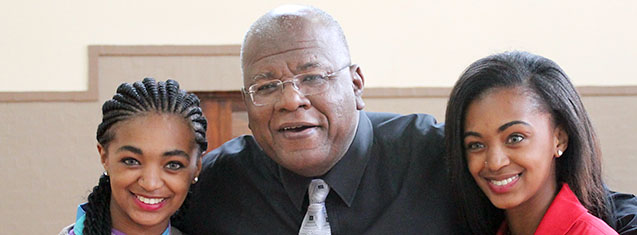
Prof Jansen and the twins pose for pictures after enjoying a laugh and chat at the lunch event.
Numerous sets of twins and a set of triplets were entertained by, and enjoyed lunch with, the Vice-Chancellor and Rector of the university, Prof Jonathan Jansen. Wednesday 12 August 2015 marked an extraordinary day in the Kovsie history book.
The Reitz Hall in the Centenary complex was filled with echoes of laughter as Prof Jansen told “twin jokes” he had Googled earlier for the occasion. Save for the humour, he said that twins and triplets represent a unique bond. “After all, we should be striving for a way of being together,” he said, speaking about the quest for national solidarity.
Sitting in groups of six, and after the introductions, the duos and trio were soon engaged in conversation.
Anita and Mikita Miza, who were sharing a table with Marike and Ilna Marais, told stories from their childhood.
“We did not realise that we were twins until we were in grade one,” said Anita, who is studying the same course as her sister. Mikita is in the second year of her BSoc Science degree, while her twin is a year ahead. She had to remain in Mtata, their hometown, for a year while Anita began her first year. “It was the longest year of my life,” said Mikita.
Marike and Ilna are first years in Physiotherapy and Optometry, respectively. When asked by Prof Jansen what they never share, the non-identical twins were quick to reply: “clothes,” although they still share a room. When they were in high school, fellow learners struggled to believe that Marike and Ilna are twins, because of their distinctly different looks.
The lunch united strangers, who have a unique common bond, and acted as a platform to tell interesting stories that are seldom heard.